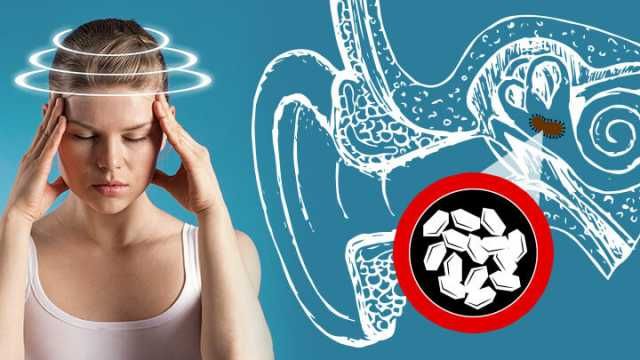
For anyone who has ever found themselves with unexplained vertigo, crystals in your ear may be a likely cause for sudden dizziness. Often triggered by certain head positions, crystals in your ear can be debilitating. The good news is, you don’t have to suffer. There is a way to balance the crystals in your ear and rid yourself of this “dizzying” condition.
So, what exactly are crystals in your ear?
The idea of crystals in your ear sounds very “new age,” if not farfetched. But for those who experience sudden and unexplained dizziness, it is very real and can be quite frightening. Crystals in your ear are one of the most common causes of vertigo or a false sensation of spinning.
Crystals (otoconia) are made of calcium, and they’ll shift from either one or both of the otolith organs of the inner ear. From there, they fall into one of the semicircular canals, disrupting the flow of fluid in that canal. The result is a condition called benign paroxysmal positional vertigo.
Benign paroxysmal positional vertigo
To break down this condition further, let’s look at the name “benign paroxysmal positional vertigo” or BPPV for short. The Vestibular Disorder Association describes BPPV like this:
- Benign: means it’s not life threatening
- Paroxysmal: means it comes suddenly and lasts only briefly
- Positional: means it is triggered by certain head positions or movements
- Vertigo: describes a false sense of rotational movement
When crystals accumulate in one of the ear canals they interfere with the normal fluid movement that these canals use to sense head motion. This causes the inner ear to send false signals to the brain.
Although the crystals move with gravity, the fluid in the canals does not. So, as the crystals begin to move the fluid — which is normally still — nerve endings in the canal become excited. And messages are sent to the brain, telling it the head is moving, even though it isn’t moving.
This false information does not match with what the other ear is sensing or even what the eyes are seeing. And it also doesn’t match what the muscles and joints are doing. The brain then reads this skewed information as vertigo. The sensation of spinning normally lasts less than one minute. Between episodes, most people feel fine. Yet, others may feel disequilibrium.
How do you know if you have crystals in your ear?

If you awake in the middle of the night feeling dizzy and disoriented, most likely after rolling over during sleep, you may have BPPV. With BPPV, any movement of the head will make the dizziness worse. It usually subsides after 30 to 60 seconds if your head remains still, suggests the Michigan Ear Institute (MEI). You may even feel dizzy from looking downward, to the side or even when lying back.
However, if you are also experiencing hearing loss then it’s probably not BPPV. Generally, people with BPPV do not experience hearing loss, ear fullness or head noise, says MEI. So, if any of these symptoms do exist, then it’s more likely a second inner ear problem.
There may not be any reasoning behind BPPV
Sometimes, there’s no known reason why you have BPPV, suggests the Mayo Clinic. That’s called idiopathic BPPV. But, if a cause can be determined, it’s often because of a minor to a severe blow to the head. It may even be the result of prolonged positioning on your back. Less likely reasons for getting BPPV may include damage to your inner ear or, rarely, damage that occurs during ear surgery. Your BPPV may also be linked to:
- Migraines
- Whiplash
- Aging inner ear
- Meniere’s disease
- Vestibular neuritis
- Labyrinthitis
If you think you have BPPV, go to your doctor and have a physical examination. If dizziness is not present on the day of your examination, you may appear normal or show negative for BPPV. Your doctor may ask you to return on a day when the dizziness is present in order to perform a detailed physical examination and hopefully confirm the diagnosis with the Dix Hallpike maneuver.
What is the Dix Hallpike maneuver and how is it done?
The Dix Hallpike maneuver is a test to identify the cause of your vertigo, and it’s usually completed by a healthcare provider. It could be in your inner ear or your brain, according to New Health Advisor. If it’s in the ear, the Dix Hallpike maneuver can help determine which side is affected.
Here’s what you can expect
You will be asked to sit with your legs straight on an examination table. Your doctor will turn your head 30 degrees to 45 degrees to one side. They will quickly lay you back with your head hanging over at the end of the table. Then they will watch your eyes and observe any involuntary movements, which will help identify the cause of your vertigo.
You’ll then be asked to sit upright to recover from vertigo, and the procedure is repeated in the opposite direction.
This test can be uncomfortable for some because it reproduces symptoms of vertigo and may even cause nausea. However, it is easy to do and can be done as part of your physical exam during a doctor’s visit. Alternately, your doctor may send you to a specialist to complete the maneuver. Once it is determined that you do have BPPV and which ear is affected, your doctor may perform another test or send you to a specialist to balance the crystals in your ear.
Balancing the crystals in your ear
In the 1970s, Dr. John Epley designed a series of movements that were less invasive, less risky and more effective at dislodging the crystals from the semicircular canals. This maneuver is called the Epley maneuver and it is commonly used today. These movements bring the crystals back to the utricle where they belong, thus treating the symptoms of vertigo.
Originally, the Epley maneuver was designed to be done with a healthcare provider. However, according to John Hopkins Medicine, the home version of the Epley maneuver is similar. You can do these movements with or without help, in your own home. Please note: If you have any problems with your cervical spine, you should not complete the home version of the Epley maneuver. You should have a healthcare provider perform the maneuver with you.
Your healthcare provider will tell you how often to do this procedure. And of course, after performing the Dix Hallpike maneuver, they will also tell you whether your right or left ear is causing symptoms. Additionally, they may even ask you to do it three times a day until your symptoms have been gone for 24 hours.
Balancing the crystals in each ear
John Hopkins Medicine suggests balancing the crystals in your ear this way. For the right ear, try this:
- Begin by sitting on a bed.
- Turn your head 45 degrees to the right.
- Quickly lie back, keeping your head turned. Your shoulders should now be on the pillow and your head should be reclined. Wait 30 seconds.
- Now, turn your head 90 degrees to the left, without raising it. Your head will be looking 45 degrees to the left. Wait another 30 seconds.
- Turn your head and body another 90 degrees to the left, into the bed. Wait another 30 seconds. Sit up on the left side.
If the problem is in your left ear, follow these steps:
- Begin by sitting on a bed.
- Turn your head 45 degrees to the left.
- Quickly lie back and keep your head turned. Your shoulders should now be on the pillow, and your head should be reclined. Wait 30 seconds.
- Turn your head 90 degrees to the right, without raising it. Your head will now be looking 45 degrees to the right. Wait another 30 seconds.
- Turn your head and body another 90 degrees to the right, into the bed. Wait another 30 seconds. Sit up on the right side.
Vertigo can be frightening. But with these simple and non-evasive maneuvers, you can balance the crystals in your ear and free yourself from ongoing sensations of spinning. Good luck!
— Katherine Marko

